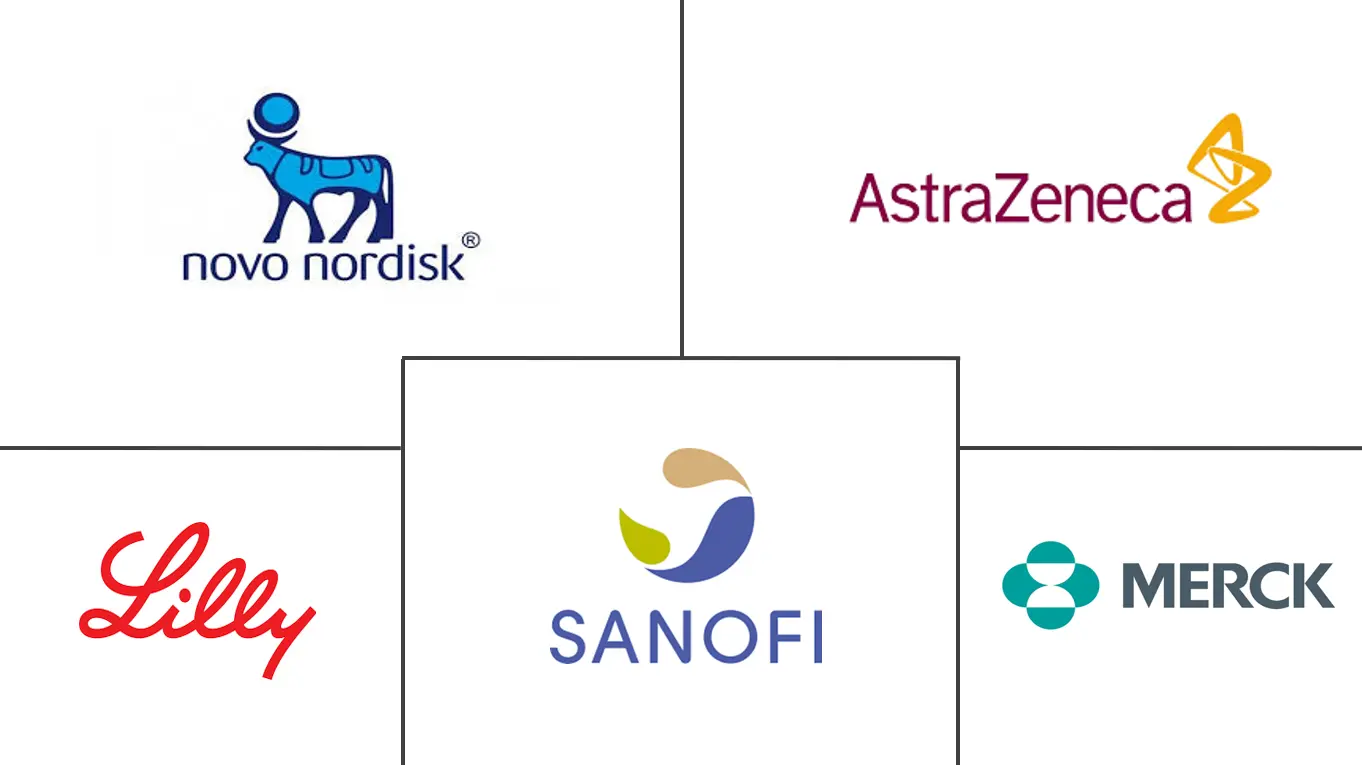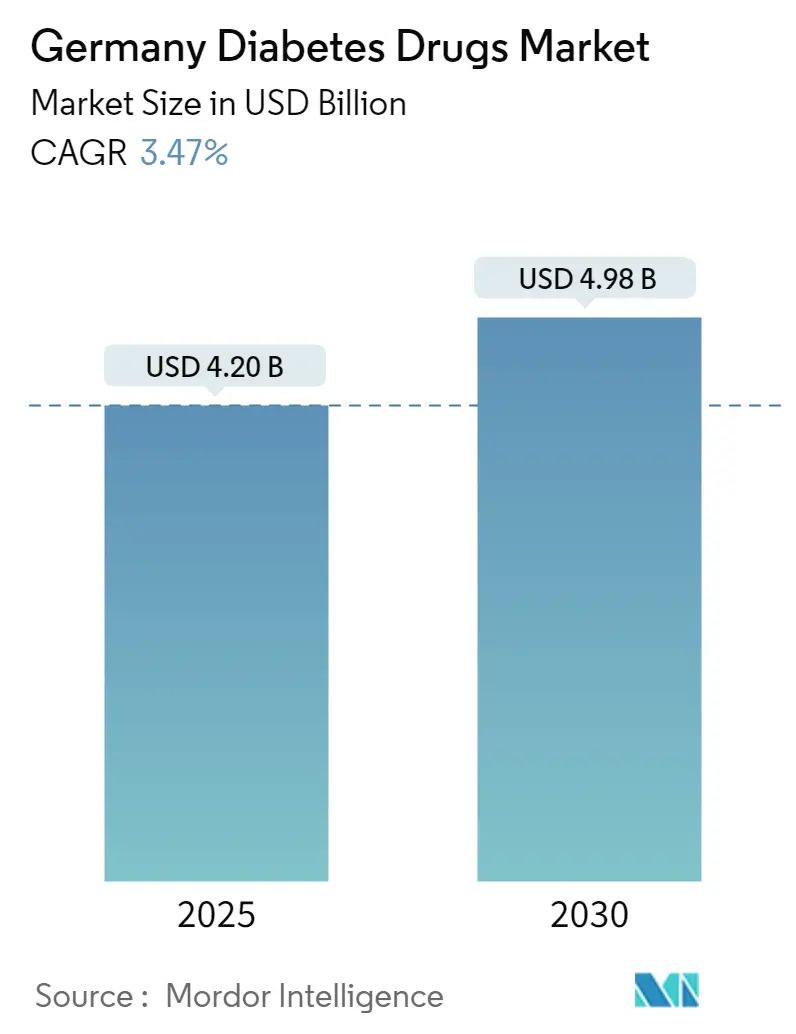
Germany Diabetes Drugs Market Analysis by Mordor Intelligence
The Germany Diabetes Drugs Market size is estimated at USD 4.20 billion in 2025, and is expected to reach USD 4.98 billion by 2030, at a CAGR of 3.47% during the forecast period (2025-2030).
The rate of newly diagnosed Type 1 and Type 2 diabetes cases is seen to increase, mainly due to obesity, unhealthy diet, and physical inactivity. The rapidly increasing incidence and prevalence of diabetic patients and healthcare expenditure are indications of the increasing usage of diabetic care drugs.
Diabetes is a significant health problem and one of the tremendous challenges for healthcare systems all over Germany. The disease's growing incidence, prevalence, and progressive nature encouraged the development of new drugs to provide additional treatment options for diabetic patients. The roll-out of many new products, increasing international research collaborations in technology advancement, and increasing awareness about diabetes among the people are some of the market opportunities for the players in the Germany diabetes drugs market.
Stringent government policies and favorable regulations by WHO in Germany are encouraging companies to develop innovative products. Penetration of these products in the German market supports local organizations in their clinical research trials and ensures ease of management, facilitating the discovery process.
Therefore, owing to the aforementioned factors the studied market is anticipated to witness growth over the analysis period.
Germany Diabetes Drugs Market Trends and Insights
The oral anti-diabetic drugs segment holds the highest market share in the Germany Diabetes Drugs Market in the current year
The oral anti-diabetic drugs segment holds the highest market share of about 59.4% in the Germany Diabetes Drugs Market in the current year.
Oral Anti-Diabetic Drugs are available internationally and are recommended for use when escalation of treatment for type 2 diabetes is required along with lifestyle management. Oral agents are typically the first medications used in treating type 2 diabetes due to their wide range of efficacy, safety, and mechanisms of action. Anti-diabetic drugs help diabetes patients control their condition and lower the risk of diabetes complications.
People with diabetes may need to take anti-diabetic drugs for their whole lives to control their blood glucose levels and avoid hypoglycemia and hyperglycemia. Oral anti-diabetic agents present the advantages of easier management and lower cost. So they became an attractive alternative to insulin with better acceptance, which enhances adherence to the treatment.
Germany witnessed an alarming increase in the prevalence of diabetes in recent years. Patients with diabetes require many corrections throughout the day to maintain nominal blood glucose levels, such as oral anti-diabetic medication or ingestion of additional carbohydrates by monitoring their blood glucose levels. The rate of newly diagnosed Type 1 and Type 2 diabetes cases is seen to increase, mainly due to obesity, unhealthy diet, and physical inactivity. The rapidly increasing incidence and prevalence of diabetic patients and healthcare expenditure are indications of the increasing usage of diabetic drugs.
Owing to the above factors, the market will likely continue to grow.
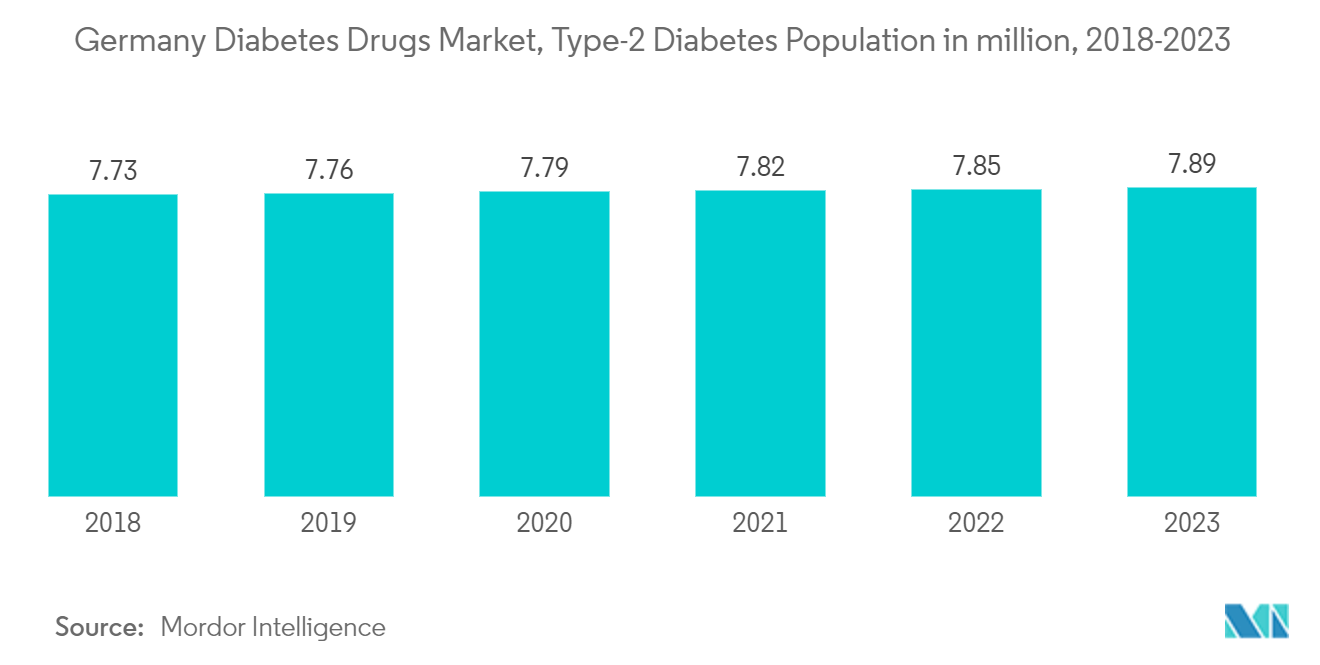
Sodium-Glucose Cotransport -2 (SGLT-2) Inhibitor segment is expected to register the highest CAGR in the Germany Diabetes Drugs Market over the forecast period
Sodium-Glucose Cotransport -2 (SGLT-2) Inhibitor Segment is expected to dominate the Germany Diabetes Drugs Market and register a CAGR of 9.2% over the forecast period.
SGLT-2 inhibitors, also called gliflozins, are a medicine class used to lower high blood glucose levels in people with type 2 diabetes. SGLT-2 inhibitors act independently of beta-cell function in the pancreas. SGLT-2 drugs significantly manage cardiovascular risk factors, including blood pressure, cardiac function, and antiinflammatory activity. SGLT-2 inhibitors are effective at lowering hemoglobin A1c levels and improving weight loss. They include a low risk of hypoglycemia and are usually well tolerated.
According to European Observatory on Health Systems and Policies, Germany includes the world's oldest social health insurance (SHI) system. Health insurance is compulsory. People with an income above a fixed threshold or belonging to a particular professional group can opt out of SHI coverage and enroll in private health insurance (PHI). About 11 % of the population is covered by PHI and 89 % by SHI. Although coverage is universal for all legal residents, only 0.1 % of the population does not contain health insurance.
Diabetes can be considered a data management disease, and an example of real-world acquisition of health and treatment data informs an integrated and personalized chronic disease management. Both patients and diabetes care providers use continuously collected metabolic, treatment, and lifestyle data in joint decision-making on treatment.
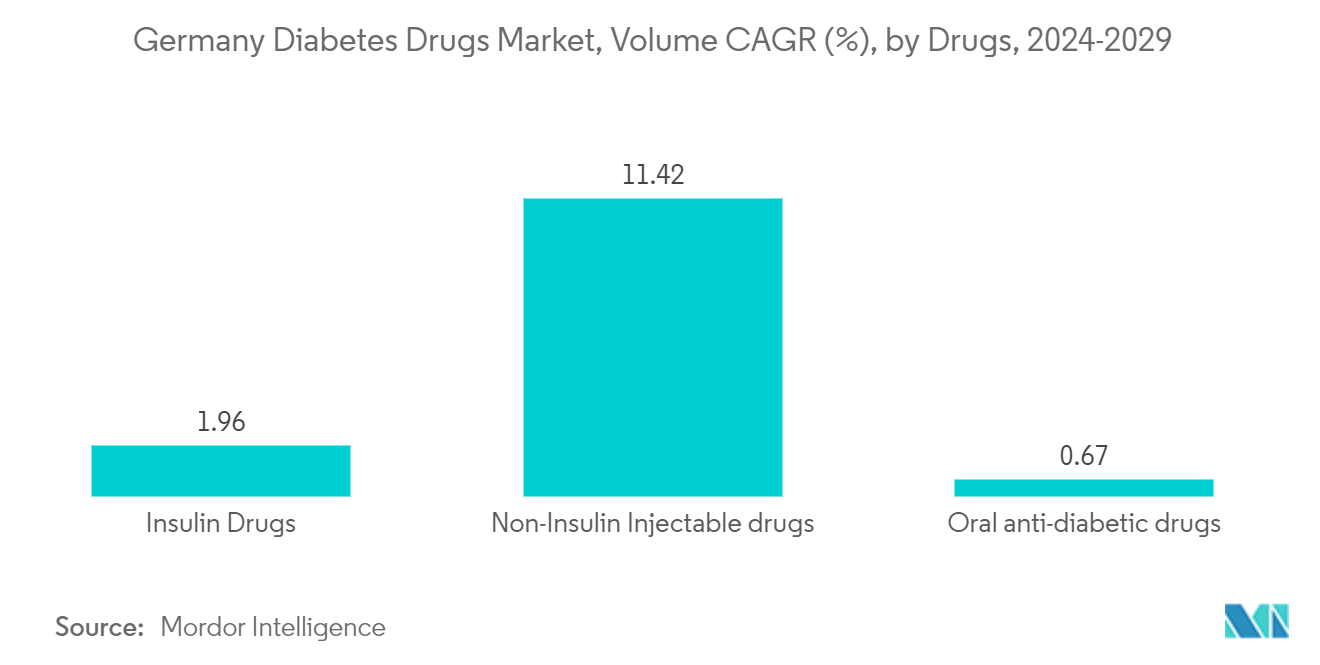
Competitive Landscape
The Germany Diabetes Drugs Market is fragmented, with major manufacturers, namely Eli Lilly, Sanofi, Novo Nordisk, AstraZeneca, and other generic players, holding a presence in the region. A major share of the market is held by manufacturers concomitant with strategy-based M&A operations and constantly entering the market to generate new revenue streams and boost existing ones.
Germany Diabetes Drugs Industry Leaders
Novo Nordisk A/S
Sanofi Aventis
AstraZeneca
Eli Lilly and Company
Merck
- *Disclaimer: Major Players sorted in no particular order
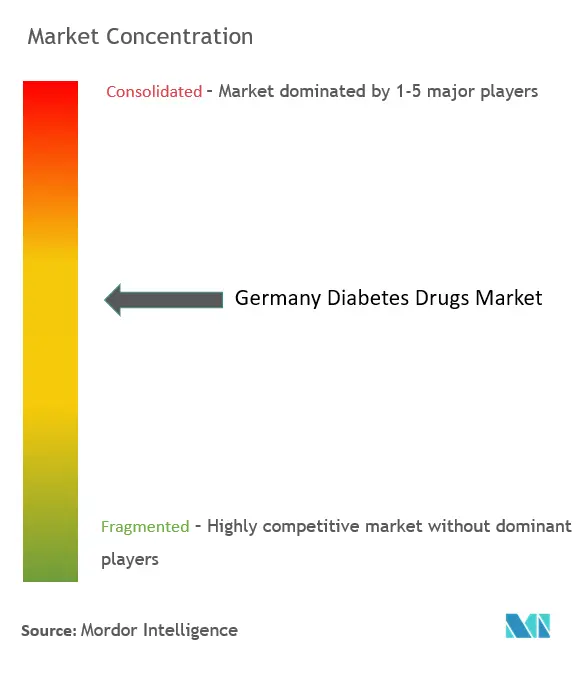
Recent Industry Developments
- February 2023: AstraZeneca's Forxiga (dapagliflozin) was approved in the European Union to extend the indication for heart failure with reduced ejection fraction to cover patients across the full spectrum of left ventricular ejection fraction. It includes HF with mildly reduced and preserved ejection fraction.
- March 2022: Eli Lilly and Boehringer Ingelheim gained approval for heart failure treatment from the EU for sodium-glucose co-transporter-2-inhibitor, Jardiance (empagliflozin).
Germany Diabetes Drugs Market Report Scope
Diabetes Drugs are used to manage diabetes mellitus by lowering the glucose level in the blood. The Germany Diabetes Drugs Market is segmented into drugs. The report offers the value (in USD) and volume (in units) for the above segments.
| Basal or Long Acting Insulins | Lantus (Insulin Glargine) |
| Levemir (Insulin Detemir) | |
| Toujeo (Insulin Glargine) | |
| Tresiba (Insulin Degludec) | |
| Basaglar (Insulin Glargine) | |
| Bolus or Fast Acting Insulins | NovoRapid/Novolog (Insulin Aspart) |
| Humalog (Insulin Lispro) | |
| Apidra (Insulin Glulisine) | |
| Traditional Human Insulins | Novolin/Actrapid/Insulatard |
| Humulin | |
| Insuman | |
| Biosimilar Insulins | Insulin Glargine Biosimilars |
| Human Insulin Biosimilars |
| Biguanides | Metformin |
| Alpha-Glucosidase Inhibitors | Alpha-Glucosidase Inhibitors |
| Dopamine D2 receptor agonist | Bromocriptin |
| SGLT-2 inhibitors | Invokana (Canagliflozin) |
| Jardiance (Empagliflozin) | |
| Farxiga/Forxiga (Dapagliflozin) | |
| Suglat (Ipragliflozin) | |
| DPP-4 inhibitors | Onglyza (Saxagliptin) |
| Tradjenta (Linagliptin) | |
| Vipidia/Nesina(Alogliptin) | |
| Galvus (Vildagliptin) | |
| Sulfonylureas | Sulfonylureas |
| Meglitinides | Meglitinides |
| GLP-1 receptor agonists | Victoza (Liraglutide) |
| Byetta (Exenatide) | |
| Bydureon (Exenatide) | |
| Trulicity (Dulaglutide) | |
| Lyxumia (Lixisenatide) | |
| Amylin Analogue | Symlin (Pramlintide) |
| Insulin combinations | NovoMix (Biphasic Insulin Aspart) |
| Ryzodeg (Insulin Degludec and Insulin Aspart) | |
| Xultophy (Insulin Degludec and Liraglutide) | |
| Oral Combinations | Janumet (Sitagliptin and Metformin) |
| Insulins | Basal or Long Acting Insulins | Lantus (Insulin Glargine) |
| Levemir (Insulin Detemir) | ||
| Toujeo (Insulin Glargine) | ||
| Tresiba (Insulin Degludec) | ||
| Basaglar (Insulin Glargine) | ||
| Bolus or Fast Acting Insulins | NovoRapid/Novolog (Insulin Aspart) | |
| Humalog (Insulin Lispro) | ||
| Apidra (Insulin Glulisine) | ||
| Traditional Human Insulins | Novolin/Actrapid/Insulatard | |
| Humulin | ||
| Insuman | ||
| Biosimilar Insulins | Insulin Glargine Biosimilars | |
| Human Insulin Biosimilars | ||
| Oral Anti-diabetic drugs | Biguanides | Metformin |
| Alpha-Glucosidase Inhibitors | Alpha-Glucosidase Inhibitors | |
| Dopamine D2 receptor agonist | Bromocriptin | |
| SGLT-2 inhibitors | Invokana (Canagliflozin) | |
| Jardiance (Empagliflozin) | ||
| Farxiga/Forxiga (Dapagliflozin) | ||
| Suglat (Ipragliflozin) | ||
| DPP-4 inhibitors | Onglyza (Saxagliptin) | |
| Tradjenta (Linagliptin) | ||
| Vipidia/Nesina(Alogliptin) | ||
| Galvus (Vildagliptin) | ||
| Sulfonylureas | Sulfonylureas | |
| Meglitinides | Meglitinides | |
| Non-Insulin Injectable drugs | GLP-1 receptor agonists | Victoza (Liraglutide) |
| Byetta (Exenatide) | ||
| Bydureon (Exenatide) | ||
| Trulicity (Dulaglutide) | ||
| Lyxumia (Lixisenatide) | ||
| Amylin Analogue | Symlin (Pramlintide) | |
| Combination drugs | Insulin combinations | NovoMix (Biphasic Insulin Aspart) |
| Ryzodeg (Insulin Degludec and Insulin Aspart) | ||
| Xultophy (Insulin Degludec and Liraglutide) | ||
| Oral Combinations | Janumet (Sitagliptin and Metformin) | |
Key Questions Answered in the Report
How big is the Germany Diabetes Drugs Market?
The Germany Diabetes Drugs Market size is expected to reach USD 4.20 billion in 2025 and grow at a CAGR of 3.47% to reach USD 4.98 billion by 2030.
What is the current Germany Diabetes Drugs Market size?
In 2025, the Germany Diabetes Drugs Market size is expected to reach USD 4.20 billion.
Who are the key players in Germany Diabetes Drugs Market?
Novo Nordisk A/S, Sanofi Aventis, AstraZeneca, Eli Lilly and Company and Merck are the major companies operating in the Germany Diabetes Drugs Market.
What years does this Germany Diabetes Drugs Market cover, and what was the market size in 2024?
In 2024, the Germany Diabetes Drugs Market size was estimated at USD 4.05 billion. The report covers the Germany Diabetes Drugs Market historical market size for years: 2019, 2020, 2021, 2022, 2023 and 2024. The report also forecasts the Germany Diabetes Drugs Market size for years: 2025, 2026, 2027, 2028, 2029 and 2030.
Page last updated on:
Germany Diabetes Drugs Market Report
Statistics for the 2025 Germany Diabetes Drugs market share, size and revenue growth rate, created by Mordor Intelligence™ Industry Reports. Germany Diabetes Drugs analysis includes a market forecast outlook for 2025 to 2030 and historical overview. Get a sample of this industry analysis as a free report PDF download.
